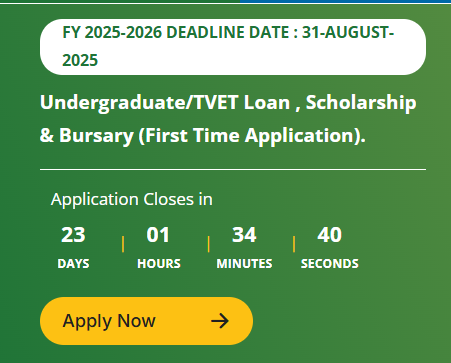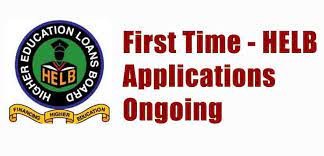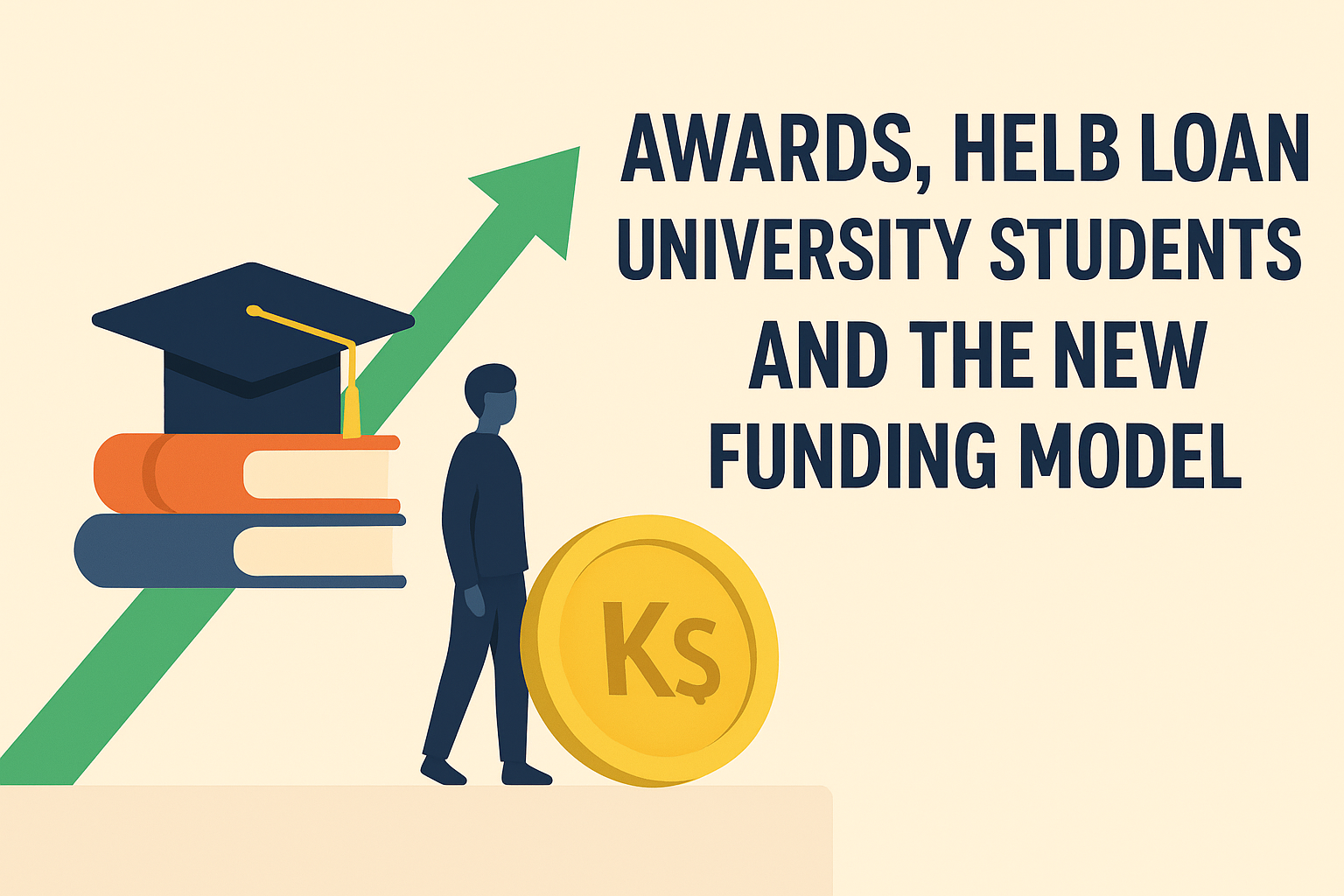
Now Open: 2025/2026 First-Time Applications for Undergraduate and TVET Loans
Applications for the 2025/2026 academic year are now open for first-time applicants seeking Undergraduate or TVET Loans, Scholarships, and Bursaries. The deadline to apply is 31 August 2025.
HELB Portal Loan is one of the funding schemes or programs of the Kenyan government that allows students to fund their college or university education. It is a loan that can be used by students; however, the former ones must have obtained government funding before the 2023/2024 academic year.
In 2025, the continuing students, i.e. those who entered university or college before 2023 use this loan primarily. Through the HELB portal, they also access the loans by applying, tracking, and managing them online.
The existence of HELB loans has contributed to the funding of the higher education of thousands of students in Kenya. Most students with low and middle income families depend on the loans to settle their tuition, books, rooms and other school expenses.
In the absence of HELB, not all students would be in a position to study in universities or colleges. The loan has ensured the inclusivity and access to education in the country.
The ease of Accessing Loans with the HELB Portal
With the help of the HELB portal, students can apply for the loans, monitor the application progress, identify the disbursement, and also review the loan statements without moving to a physical space as all these services are done online. It saves time; it lessens the physical paper work and long queues at HELB offices.
Through the HELB portal, students have also been able to change their personal details in 2025, and apply and be loaned at subsequent times on the portal and even download compliance certificates with ease.
HELB Loans Available
🎓 Undergraduate Loans
These loans are for students studying for their first degree in public or private universities. You can apply through the HELB portal once you’re admitted to a university. The loan helps cover tuition, accommodation, and upkeep.
🛠️ TVET Loans
TVET (Technical and Vocational Education and Training) loans are for students in approved technical institutes and colleges. These loans help pay for fees, tools, and learning materials. It’s meant to support students learning hands-on skills.
🎓 Postgraduate Loans
If you’re pursuing a Master’s or PhD, HELB also provides postgraduate loans. They are available to students studying in accredited universities in Kenya. You’ll need to provide proof of admission and course details during application.
🏥 Afya Elimu Fund
This is a special loan for students pursuing health related courses like nursing, clinical medicine, and lab tech. It’s offered in partnership with USAID and other health agencies. It supports learners in medical training colleges across Kenya.
📚 Jielimishe Loan
This loan targets salaried people who want to continue their education part-time. It helbs cover school fees for diploma, undergraduate, or postgraduate courses. You must be formally employed and have a payslip to qualify.
🏛️ Constituency or County Education Loans
Some counties like Kakamega or Busia offer education loans through HELB. These loans are funded by county governments and help local students access higher education. You usually need to be a resident of that county to apply.
help loan news and update
Type of Loan Application
There are two types of undergraduate loan applications:
- First Time Application-This is for applicants who are applying for the first time.
- Heln Second Subsequent Application-This is for applicants who are applying for the second, third, or fourth time as per the program duration.
Note: The number of loans one is eligible for depends on the program duration. For example, one is given a loan 4 times for a 4-year program or 5 times for a 5-year program.
🎓 HELB First Time Application for loan

✅ Eligibility Criteria for First-Time Applicants
To qualify for a HELB loan for the first time in 2025, you must:
- Be a Kenyan citizen with a valid national ID.
- Have an admission letter from a recognized university, college, or TVET institution.
- Be enrolled in a full-time or part-time government-approved course.
- Not have received any HELB loan before.
This loan is mainly for students who need financial assistance to pursue higher education in Kenya.
📄 Required Documents Before You Apply
Before starting your application, make sure you have:
- A valid national ID card (front and back scanned).
- Your admission letter and KCSE result slip or certificate.
- A working email address and phone number.
- Copies of your parents’ or guardians’ ID cards.
- Your Bank account details (preferably in your name).
- Recent colored passport-size photo.
- Your institution’s name and course details.
Having these documents ready will save you time during the application process.
📝 Step-by-Step HELB Loan Application Guide
Applying for a HELB loan is a crucial step for many Kenyan students pursuing higher education. Once you’ve confirmed your eligibility and gathered all the necessary documents, here’s a clear breakdown of how to complete your loan application through the HELB student portal:
✅ 1. Visit the Official HELB Student Portal
Go to the helb portal official website and click helb application form to begin your application process. This portal is where all loan services including helb registration loan, application, tracking, and disbursement are handled.
✅ 2. Create Your Account or Log In
If you are a first-time applicant, select the “Register” option and fill in the required details to create your HELB account. For returning users, simply log in with your existing credentials.
✅ 3. Choose the Appropriate Loan Application Form
Once logged in, select the loan form that matches your education level:
- First Time Undergraduate Loan (LAF)
- TVET Loan
- Jielimishe Loan (for salaried students)
- Or other specific products available at the time
Make sure you select the correct loan type to avoid delays or disqualification.
✅ 4. Enter Your Personal, Academic & Banking Details
Carefully fill in all required fields, including:
- Bio-data: Your full name, ID number, contact info, etc.
- Academic details: Current institution, course, year of study
- Family background: Parent/guardian information and income
- Banking details: Ensure you provide an active bank account in your name for helb portal disbursement purposes
💡 Tip: Double-check every section for accuracy before proceeding.
✅ 5. Upload Required Supporting Documents
Scan and upload clear, legible copies of all the documents required. These may include:
- National ID (both sides)
- Parent(s)’ or guardian’s ID
- Admission letter
- KCSE or KCPE results slip
- Recent passport-size photo
- Bank plate or ATM card (showing your name and account number)
Make sure each document is uploaded in the format specified (e.g., PDF, JPEG), and under the allowed size limit.
✅ 6. Preview and Submit the Application
Before clicking “Submit,” review your entire application carefully. Check for:
- Spelling errors
- Missing fields
- Incorrect document uploads
Any error could lead to rejection or delays in processing.
Once satisfied, submit your application online through the portal.
✅ 7. Print Two Copies of the Completed Form
After successful submission, download and print TWO copies of your Loan Application Form (LAF). These will be used for institutional and HELB verification purposes.
✅ 8. Get the Form Officially Signed & Stamped
Take the printed form to your institution’s dean or registrar’s office for stamping and official signing. This serves as helb loan confirmation of your student status and course enrollment.
✅ 9. Submit the Completed Form to HELB
Finally, submit one of the signed forms to HELB through any of the following:
- HELB Head Office (Anniversary Towers)
- Any Huduma Centre near you
- Via registered courier service (for those living far from HELB centers)
Always retain the second stamped copy for your records.
🛡️ Important Note:
Your application is not complete until the signed form reaches HELB. Online submission alone is not sufficient. HELB will only process your loan after receiving the physical, verified documents.
📄 4. HELB Subsequent Loan Application via Portal
Once you’ve successfully applied for your helb student portal first time application and received funding, you’re required to apply for helb student portal subsequent loan application each academic year to continue receiving support. The process for applying for a subsequent loan is much simpler and entirely online, as your records already exist in the system.

✅ Who Is Eligible for a Subsequent HELB Loan?
You qualify for a subsequent loan application if:
- You have previously received a HELB loan.
- You are still a continuing student in the same institution.
- You meet the academic progress and institutional requirements.
Subsequent applications ensure that HELB continues to fund your studies based on annual reviews and budget availability.
🖥️ How to Apply for a HELB Subsequent Loan (Step-by-Step Guide)
✅ Step 1: Visit the HELB Portal
Go to the official HELB website: https://www.helb.co.ke
From the homepage, click on “Student Portal Login”. This will redirect you to the login interface.
✅ Step 2: Log In to Your Student Portal
Use your registered email address and password to log into the portal.
If you’ve forgotten your password, use the “Forgot Password” option to reset it.
✅ Step 3: Select “Subsequent Application”
Once logged in, you’ll see various application options.
Click on “Subsequent Undergraduate Loan Application” or your relevant loan category (TVET, Jielimishe, etc.).
Note: Do NOT choose “First Time Application” again. That’s only for new applicants.
✅ Step 4: Update Your Details
The portal will pre-fill your earlier submitted information. Review and update any changes in:
- Personal information
- Academic details (e.g., new year of study, semester)
- Banking details (ensure your bank info is still valid)
Make sure everything is up-to-date before proceeding.
✅ Step 5: Fill in the Required Sections
Go through the form and ensure all the fields are completed. You may be asked to re-enter or confirm:
- Family background
- Parent/guardian information
- Updated school fee statement
- Bank account details
✅ Step 6: Agree to Terms and Conditions
Once you’ve reviewed everything, read the declaration carefully.
Tick the box to agree to HELB’s terms and conditions of funding.
✅ Step 7: Submit the Form
Click on “Submit” at the end of the form.
You will see a confirmation message once your application has been submitted successfully.
📌 Unlike the first-time application, you do NOT need to print, sign, or deliver the form physically. It is completely online.
✅ Step 8: Await Disbursement
After submitting, HELB will process your loan request.
To check your disbursement status:
- Go to your Student Portal dashboard
- Click on Loan Status or Disbursement History
🎓 Awards, HELB Loan University Students, and the New Funding Model
The Higher Education Loans Board (HELB) plays a crucial role in making higher education accessible to Kenyan university students by offering financial support. With the introduction of the New Funding Model (NFM), this support has become more structured, transparent, and targeted. The revised model is specifically designed to prioritize students from disadvantaged backgrounds, offering a balanced combination of loans, bursaries, and scholarships based on individual financial needs.

Under this needs-based approach, students are categorized into four distinct groups: Vulnerable, Extremely Needy, Needy, and Less Needy. Each category receives a tailored funding package. For example, students classified as Vulnerable may receive full financial support, with a substantial portion in the form of non-repayable bursaries and scholarships, while students deemed Less Needy may receive only a partial loan. This system ensures that financial resources are distributed more fairly and used more effectively.
By implementing this new structure, HELB and the Kenyan government aim to promote equity and inclusivity in higher education. It enables more students, regardless of their financial background, to enroll and remain in university without the constant threat of dropping out due to lack of funds. The New Funding Model marks a significant shift from uniform allocations to a personalized and sustainable funding strategy, giving every deserving student a genuine chance to succeed.
⚠️ Important Tips:
- Always apply before the helb application deadline (usually early in the semester).
- Use a stable internet connection to avoid incomplete submissions.
- Double-check your bank account and institution details—errors can delay your disbursement.
- HELB may send SMS/email notifications about your application status.
📊 HELB Loan Limits by Education Category & Institution
| Education Level / Loan Type | Institution / Department | Loan Amount (Per Year) | Remarks |
| 🧑🎓 Undergraduate Students | Public Universities (Govt Sponsored – KUCCPS) | KSh 37,000 – KSh 60,000 | Tuition + upkeep; depends on need level |
| 🧑🎓 Undergraduate Students | Private Universities (Self-Sponsored) | KSh 40,000 – KSh 60,000 | For full-time students only |
| 🏥 Medical Students | KMTC, Nursing Colleges | KSh 40,000 – KSh 70,000 | Higher needs for practicals/attachments |
| 🧑🔧 TVET Students | Approved TVET Institutions | KSh 26,000 – KSh 40,000 | Includes KSh 13,000 tuition & 13,000 upkeep |
| 🎓 Postgraduate Students | Master’s / PhD (Public or Private) | KSh 60,000 – KSh 200,000 | Based on program & fees structure |
| 🏫 Teaching Students | Diploma in Education (Public/Private) | KSh 30,000 – KSh 60,000 | Subject to course type |
| 💼 Jielimishe Loan (Working Students) | Employed, Self-sponsored learners | KSh 60,000 – KSh 500,000 | Paid directly to institution |
| 🧾 HELB Afya Loan | Health Sector Professionals (Postgrad) | KSh 70,000 – KSh 600,000 | Depends on duration & course type |
| 👨👩👧👦 Orphans/Vulnerable Groups | Any institution (Proof required) | Up to KSh 70,000 | May qualify for higher amounts or bursaries |
| 🏛️ HELB Bursary | Very needy students | KSh 4,000 – KSh 8,000 | Non-repayable bursary portion |
🎯 Understanding Loan Status & Approval Process
Once you submit your HELB loan application, the next step is waiting for approval. Understanding how long this takes, how to track your status, and what each status means is very important.
⏳ How Long Does HELB Loan Approval Take?
HELB loan approval usually takes 4 to 6 weeks after the application deadline. However, this timeline can change depending on:
- The volume of applications received
- Whether your documents are complete and verified
- If your institution has confirmed your admission details
💡 Tip: Apply early in the academic cycle to avoid delays.
🔎 How to Check Your HELB Loan Application online Status
You can track the progress of your application on the HELB Student Portal:
- Visit the official HELB portal
- Log in to your account
- Go to the ‘Loan Status’ section
- You’ll see an updated status like Verified, Allocated, or Disbursed
Some status messages also appear via SMS or email notifications if you enabled them.
📌 Meaning of HELB Loan Status & Disbursement
Here’s what the different status labels on your HELB account mean:
| Status | Meaning |
| Pending | Your application has been received but not yet reviewed. |
| Verified | HELB has checked and confirmed your documents and details. |
| Allocated | Your loan amount has been approved and allocated for disbursement. |
| Disbursed | The money has been sent to your institution or your bank/mobile wallet. |
| Rejected | Your application was not approved (reason usually provided in the portal). |
| Incomplete | Some required documents or information are missing. |
| Awaiting Allocation | Application is verified but not yet assigned a loan amount. |
💬 Note: Always ensure your application is complete with correct documents to avoid unnecessary delays.
💸 HELB Loan Disbursement Explained
⏱️ Disbursement Timelines & Channels
Once your HELB loan application is approved, the disbursement process typically follows the academic calendar and funding schedule set by HELB. Most loans are disbursed at the beginning of each semester.
Disbursement usually occurs within 2–4 weeks after loan approval. However, timelines may vary depending on:
- The date of application approval
- Institutional confirmation of admission
- Availability of government funds
HELB uses three main disbursement channels:
- Bank Account (Maintenance Allowance): Funds for personal upkeep are sent directly to the student’s bank account. Ensure your account is active and linked during the application process.
- Institution’s Account (Tuition Fees): Tuition fees are sent directly to your college or university to cover academic costs.
- M-Pesa (for select loans and bursaries): Some applicants may receive disbursements or communication alerts via M-Pesa. Always register with your correct mobile number.
⚠️ Common Delays and How to Avoid Them
Disbursement delays can be frustrating, but many are avoidable. Some common causes include:
- Incorrect or mismatched bank details
- Unverified student registration at your institution
- Incomplete application or missing documents
- Delays in institutional confirmation
Tips to avoid delays:
- Double check all details before submitting your application.
- Make sure your institution has confirmed your registration with HELB.
- Monitor the portal regularly for any issues or updates.
- Use your own, active bank accoun shared or closed accounts can cause rejections.
🔍 How to Track Your helb disbursement schedule
You can easily check the status of your loan disbursement online. Here’s how:
- Login to the HELB Portal: Use your student credentials to access your account.
- Go to “Loan Status” Section: This page will show you detailed updates on your application.
- Check for Key Status Updates:
- Disbursed to Bank: Funds have been sent to your account.
- Disbursed to Institution: Tuition has been sent to your school.
- Pending: The loan is still being processed.
- Allocated: Funds have been set aside for you but not yet sent.
- Verified: Your information has been confirmed, and you’re queued for disbursement.
- Disbursed to Bank: Funds have been sent to your account.
You may also receive SMS notifications once disbursement is made, so keep your registered number active and accessible.
💳 HELB Portal Loan Repayment Options
When does HELB loan repayment start?
HELB loan repayment officially begins one year after graduation, whether you’ve secured employment or not. However, borrowers are encouraged to start repaying earlier if they can. This helps reduce the loan balance and interest accumulation. TVET students may have slightly different timelines depending on the duration of their courses.
Repayment Methods: Bank, M-Pesa, and Employer Deductions
HELB offers flexible repayment options for convenience:
- Bank Payment: You can repay via direct deposit to the HELB bank accounts (such as Kenya Commercial Bank, Cooperative Bank, etc.). Include your National ID as the reference.
- M-Pesa Payment:
- Go to M-PESA > Lipa na M-PESA > Paybill
- Enter HELB Paybill number 200800
- Use your National ID Number as the account number.
- Enter the amount and complete the transaction.
- Go to M-PESA > Lipa na M-PESA > Paybill
- Employer Deduction:
If you are formally employed, your employer should deduct monthly loan repayments from your salary and remit them to HELB. You must inform HELB about your employer after securing a job to facilitate this process.
TVET vs Undergraduate Repayment Differences
TVET loan repayment terms are generally shorter and may involve smaller amounts, depending on the type of course pursued. Undergraduate loans often span longer durations and may have a slightly higher interest accrual due to the larger loan amounts. Regardless of loan type, the repayment process through the portal remains largely the same.
✅ HELB Clearance & Compliance Certificate
What is a HELB Compliance Certificate?
A HELB Compliance Certificate is an official document issued by HELB confirming that an individual is either repaying their loan, has completed repayment, or never borrowed from HELB. It serves as proof of financial responsibility and HELB compliance.
How to Get a Compliance Certificate Through the Portal
Follow these steps to obtain your HELB compliance or clearance certificate online:
- Log in to the HELB Student Portal
- Go to the “Compliance Certificate” section.
- Click on “Request Certificate”.
- If eligible, the certificate will be generated instantly for download.
If you are not compliant (e.g. haven’t started repayment or have arrears), you may be prompted to make payment first or contact HELB.
Why Do Employers or Institutions Require It?
- Public Service Commission (PSC) job applications often require a HELB compliance certificate as part of the ethics and integrity documents.
- Employers use it to verify that you’re not in default.
- Institutions and scholarship boards may request it before issuing funding or accepting you into programs.
- It’s also required for various government tenders and appointments.
❗ Common Issues in HELB Loan Portal Use
Despite the HELB portal being a valuable resource for students and graduates, users often face technical and process-related issues. Understanding these common problems and how to resolve them quickly can save time and reduce delays in loan processing and disbursement.
🔄 Disbursement Errors
Disbursement errors are among the most frequent challenges faced by HELB Beneficiaries & Verification. These can include receiving less than the expected amount, the funds not reflecting in your account, or disbursement being made to the wrong institution or bank.
- Causes: Inaccurate bank details, delayed institution verification, or pending compliance issues can cause such errors.
- What to do: Always ensure your banking or M-Pesa details are updated on the portal. Also, verify your institution details and confirm that your account is active and verified. If you notice any inconsistency, raise the issue with HELB immediately.
🚫 Account Access Problems
Students may encounter issues logging into their HELB portal accounts due to forgotten passwords, inactive accounts, or locked profiles.
- Password Reset: Use the “Forgot Password” option to initiate a password reset. You will receive a reset link on your registered email.
- Locked Accounts: Too many failed login attempts may result in account suspension. In this case, contact HELB support to reactivate your account.
- Email or Phone Not Verified: If your contact details are not verified, you may be blocked from portal access. Always verify your email and phone number upon registration.
🆘 How to Raise a Support Ticket
If you face persistent issues or errors that cannot be resolved through the FAQ section, raising a support ticket is the best approach.
- Steps to Raise a Ticket:
- Login to the HELB Portal.
- Navigate to the ‘Support’ or ‘Help’ section.
- Click on ‘Raise a Ticket’ and fill in all the required fields, including a description of your issue.
- Attach any relevant documents or screenshots to helb clarify your problem.
- Submit the ticket and wait for email or SMS updates.
- Login to the HELB Portal.
- Response Time: HELB typically responds within 3 to 5 working days, depending on the nature of the issue.
✅ Can I change my HELB bank account after application?
Yes, you can request to change your HELB bank account by submitting a bank details amendment form. You must provide:
- A signed letter stating the reason for the change.
- A copy of your new bank ATM card or account opening letter.
- Your national ID copy.
Submit these documents physically at a HELB office or via email to contactcentre@helb.co.ke. Processing may take a few weeks.
✅ Is the HELB portal open for applications now?
The HELB portal is only open during designated application windows. These periods are usually announced via the HELB website and official social media platforms. You should regularly check the portal or sign up for alerts to stay updated on application openings.
✅ Is the HELB portal open today for subsequent applications?
To find out if the portal is currently open for subsequent applications, log into the HELB Student Portal. If the application form for your category is available, it means the window is open. HELB also updates students via their official communication channels when subsequent application periods begin.
✅ Is the HELB portal open for continuing students?
Yes, HELB provides subsequent loans for continuing students (2nd year and above). However, application windows open once per academic year, and students must apply during this period. You should visit the portal and watch out for updates or deadline announcements.
✅ Does HELB offer loans for undergraduate students?
Yes, HELB primarily offers loans and bursaries to undergraduate students pursuing degree and diploma programs in recognized Kenyan institutions. Undergraduate students can apply for helb loan First-Time (in the first year) and Subsequent Loans in later years.
✅ Is the HELB portal open for first-time applicants?
The HELB portal opens for first-time applicants at the beginning of each academic year, usually around July to October, depending on intake. If you’re a first-year student, visit the HELB application 2025 during this time and complete your registration and application before the deadline.
✅ How many times can I apply for a HELB loan?
You can apply for a HELB loan once every academic year. For most undergraduate programs, HELB allows a maximum of four (4) loan applications one for each year of study. First-time applicants and subsequent applicants must apply within the specified timelines for each academic year.
🎓 Awards, HELB Loan University Students, and the New Funding Model
The Higher Education Loans Board (HELB) plays a crucial role in making higher education accessible to Kenyan university students by offering financial support. With the introduction of the New Funding Model (NFM), this support has become more structured, transparent, and targeted. The revised model is specifically designed to prioritize students from disadvantaged backgrounds, offering a balanced combination of loans, bursaries, and scholarships based on individual financial needs.
Under this needs-based approach, students are categorized into four distinct groups: Vulnerable, Extremely Needy, Needy, and Less Needy. Each category receives a tailored funding package. For example, students classified as Vulnerable may receive full financial support, with a substantial portion in the form of non-repayable bursaries and scholarships, while students deemed Less Needy may receive only a partial loan. This system ensures that financial resources are distributed more fairly and used more effectively.
By implementing this new structure, HELB and the Kenyan government aim to promote equity and inclusivity in higher education. It enables more students, regardless of their financial background, to enroll and remain in university without the constant threat of dropping out due to lack of funds. The New Funding Model marks a significant shift from uniform allocations to a personalized and sustainable funding strategy, giving every deserving student a genuine chance to succeed.


